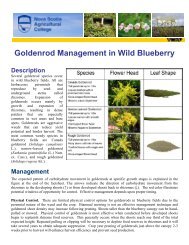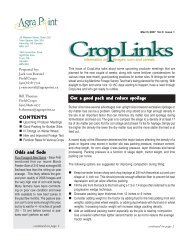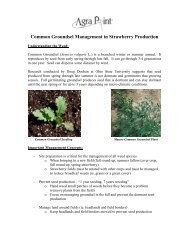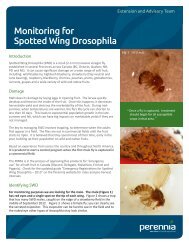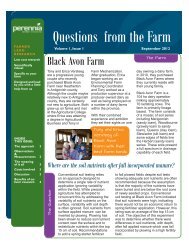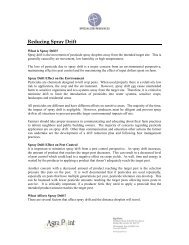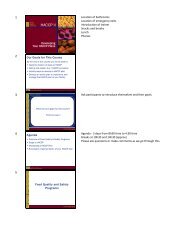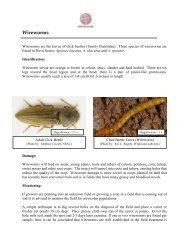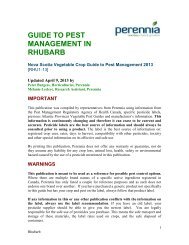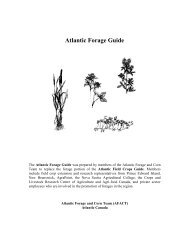Organic Pasture Management - Perennia
Organic Pasture Management - Perennia
Organic Pasture Management - Perennia
Create successful ePaper yourself
Turn your PDF publications into a flip-book with our unique Google optimized e-Paper software.
CHAPTER 9 ~ ORGANIC PASTURE MANAGEMENT<br />
INTRODUCTION<br />
Arguably, the first step in any organic production system comes with a shift in thinking. For<br />
organic livestock producers a new way of looking at pasture is critical. <strong>Pasture</strong> is no longer<br />
viewed as solely a crop to feed their animals; rather their animals are viewed as tools to manage<br />
their pasture. The subtle difference places the emphasis on the pasture management rather than<br />
on the animal management. When your emphasis shifts to the pasture you soon realize that the<br />
foundation of the pasture is in fact the soil. Catering your pasture management practices to<br />
ensure that the quality of the soil is maintained cultivates the growth of nutrient-dense, energyrich<br />
forage which in turn fosters healthy, productive animals.<br />
In production pasture systems<br />
the emphasis is on the pasture<br />
- a healthy pasture will in turn<br />
produce healthy animals.<br />
OPTIMIZING PASTURE PRODUCTIVITY<br />
Whether you are farming organically or conventionally, many producers with pastures are looking<br />
for the “ideal” pasture variety or species to increase animal performance, often looking to replant<br />
and renovate any pasture that seems to be low in productivity. Simply stated there is no perfect<br />
plant or pasture mix that will turn around a poor pasture, in reality the species planted are far less<br />
important than how the pasture is managed. <strong>Management</strong> Intensive Grazing (MIG-see Chapter<br />
2) is the best tool for optimizing pasture productivity, and as its name suggests the bulk of the<br />
work is in the thinking and decision making. The success of MIG is based on the farmer‟s ability<br />
to develop a “grass eye” or in other words a farmer‟s ability to gain intimate knowledge of their<br />
land and its capability both spatially and temporally. Daily observations through pasture walks,<br />
creative thinking and flexibility are integral components of MIG, but decisions made in a<br />
conventional system may not be the same ones made in an organic system. For example, the<br />
traditional concept of a rest period in MIG is to allow pasture an average of 30 days rest (in mid to<br />
late season), yet in an organic system such an approach may lead to problems with intestinal<br />
MARITIME PASTURE MANUAL 115
parasites. Intestinal parasites and ruminants have coevolved for thousands of years and the<br />
parasites have altered their lifecycle to coincide with the grazing behaviour of their host. Many<br />
parasites will have a 21 to 35 day lifecycle so that eggs laid in the first grazing cycle will be ready<br />
for infection at the time of the next grazing cycle. Therefore, in designing an organic pasture<br />
system, a manager must build in flexibility to alter grazing patterns depending on parasite load.<br />
Some producers will alternate grazing cycles with hay harvest therefore allowing for a greater<br />
length between egg deposition and the entrance of a host. The collection of conserved forage<br />
ensures that the quality of the grass is maintained and that it does not become over mature and<br />
less palatable.<br />
Knowing when to move animals and why you are<br />
moving them is all part of developing a “grass eye” –<br />
a requisite in <strong>Management</strong> Intensive Grazing (MIG).<br />
Ensuring adequate time for the resting of pastures fosters a tall, dense, uniform sward that<br />
maximizes the intake for each bite. Typically, cattle and sheep divide their day equally into<br />
grazing, ruminating, and sleeping and so their intake and in turn animal performance is directly<br />
related to how much they get in each bite. This is the “science” of grazing. The “art” of grazing is<br />
determined by the farmer‟s ability to produce a tall, dense, uniform pasture. There is no magic to<br />
it. It requires years of experimenting with paddock sizes, paddock layout, and rotation schedules.<br />
A common saying among graziers is, “good judgment comes from experience, and experience<br />
comes from bad judgment.” As such, many organic farmers take an incremental approach to<br />
MIG and use temporary fencing for the first few years and then develop an appropriate paddock<br />
layout with laneways and watering areas.<br />
Get’em in early…<br />
The first grazing cycle sets the stage for the rest of the season. Whenever your land can<br />
tolerate hoof action animals should be turned out. Livestock will require supplemental<br />
conserved forage, but waiting until the paddock has reached an entry height of 15-20 cm,<br />
means subsequent pastures will be over mature and poor in quality. In the spring, root<br />
reserves in grasses can tolerate more severe defoliation and have timely regrowth for the<br />
next grazing or haying cycle.<br />
MARITIME PASTURE MANUAL 116
Creating a tall, dense, uniform sward ensures that each<br />
bite is maximizing intake and in turn animal gain.<br />
<strong>Pasture</strong>-based organic livestock producers soon realize that what is left behind in the paddock is<br />
as important as what their animals harvested. Leaving an adequate residual (exit height) will<br />
allow forage plants to re-grow without having to tap their root reserves. A common rule-of-thumb<br />
of grazing is “take half, leave half” which, as it suggests, is that animals should exit when they<br />
have grazed a sward down to half the entrance height. This is another example of the “art of<br />
grazing” or where the “grass-eye” needs development. Cattle should enter swards at a height of<br />
25 cm (10 inches) and exit at 12 cm (5 inches), while sheep intake is optimized at an entrance of<br />
20 cm (8 inches) and an exit at 10 cm (4 inches). These exit heights serve several benefits in an<br />
organic system. Maintaining photosynthetic tissue with high residual heights does not deplete<br />
carbohydrate reserves, but other important factors include: 1) reduction in parasite infection; 2)<br />
maintenance of grass:legume balance to ensure a high energy pasture with little chance of bloat;<br />
3) decrease in soil compaction with the decreased stocking rate; and 4) in a healthy competitive<br />
sward there is less chance of weed invasion.<br />
How much pasture does a cow need?<br />
Most farmers aren‟t going to grab their calculators to work out the amount of forage available for<br />
their animals. Over time most graziers become comfortable in assessing the quantity of pasture in<br />
each paddock and can adjust the stocking rate accordingly. However, for those just starting<br />
out…another good rule-of-thumb is to assume that in a leafy, vegetative sward each inch<br />
provides about 90 kg (200 lbs.) of forage dry matter/acre. So, in a pasture with a sward height of<br />
25 cm (10 in.), there is 450 kg (1000 lbs) of forage available (assuming you leave half). In<br />
general, a cow will consume about 2.5 percent of her body weight per day in dry matter; therefore<br />
a 450 kg (1000 kg) cow will require 11 kg (25 lbs) of forage. As such, the 25 cm (10 in) pasture<br />
should be able to feed 40 animals (450 kg or 1000 lbs each) for one day or 20 animals for two<br />
days.<br />
MARITIME PASTURE MANUAL 117
<strong>Pasture</strong> Species<br />
<strong>Pasture</strong> species selection in organic systems does not differ greatly than that in conventional<br />
grazing management. The ideal grass-clover mixture is to have 30 to 40% clover, however under<br />
MIG the clover content can increase sharply if the sward is grazed too low. The increased clover<br />
content may increase the protein content of the forage, but at the detriment of yield. Also, organic<br />
producers lack options for bloat control and therefore must be cautious with high clover swards.<br />
Although, organic producers are encouraged to use only organic seed, the lack of availability of<br />
organic forage seed permits the use of conventional seed provided it has not been treated by any<br />
prohibitive substances (e.g., synthetic fertilizers, fungicides, or genetically modified inoculants).<br />
Maintaining 30% legume (e.g., white<br />
clover) will ensure a high quality<br />
pasture rich in both energy and<br />
protein.<br />
<strong>Pasture</strong> Fertility & Nutrient <strong>Management</strong><br />
All too often researchers and extensionists state that having animals grazing eliminates the need<br />
to add additional fertility. This is not so. In situations where the stocking rate is relatively lower<br />
than maximal (recommended in organic systems) animals will selectively graze creating an<br />
uneven distribution of manure and urine; and depending on the proximity of water and shelter the<br />
surrounding areas could also have a disproportionate amount of nutrients. To ensure that a<br />
greater area of the pasture is receiving adequate nutrients, it is recommended that pastures<br />
receive compost or fresh manure. The rate of application will depend on desired pasture<br />
productivity and on historical performance.<br />
When you begin viewing the soil as the foundation for good animal performance the use of<br />
compost on pasture makes sense. Most pastures in Atlantic Canada that have not been<br />
overgrazed should have moderate levels of organic matter (above 3.0%), and in these soils most<br />
macronutrients (N, P, K, S, Mg, and Ca) are abundant, but are often not available to fully meet<br />
the needs of rapidly growing pasture plants. The role of compost is not to directly provide these<br />
nutrients; rather compost is to inoculate the soil with living microorganisms (i.e., bacteria, fungi,<br />
protozoa, amoebae, and nematodes) which in turn enhance nutrient cycling. Creating a healthy<br />
living soil through the use of compost can have additional benefits in organic pasture systems.<br />
For example, compost can improve soil structure, thereby alleviating the damage of compaction<br />
(weeds like Canada thistle prefer compacted soils), increasito verifyng water infiltration (reducing<br />
areas that tend to puddle and get punched up by animals); increasing water retention (allowing<br />
grasses to survive drought-like conditions); and breaking down fecal matter more quickly<br />
(removing the nutrient source for intestinal parasite eggs).<br />
MARITIME PASTURE MANUAL 118
Other than manure there is no economical source of organic N, and therefore organic farmers<br />
often pass on the immediate spring green-up that cool-season grasses provide in response to<br />
nitrogen, and favour N provided by legumes such as red and white clover, and Birdsfoot trefoil.<br />
Many soils in Atlantic Canada have low amounts of available phosphorus, and if compost does<br />
not bring about desired plant tissue levels then supplemental phosphorus may be required.<br />
Unfortunately, organic P sources such as rock phosphate and soft rock phosphate (Cal-Phos) are<br />
slow in their release and cost prohibitive. If potassium levels are insufficient and winter injury of<br />
legumes and grasses like perennial ryegrass is suspected, then potassium sources such as wood<br />
ash, greensand, potassium sulphate or langebenite (Sul-Po-Mag) may be used.<br />
Liming of pastures is very common in Atlantic Canada and is required quite frequently. Soil pH in<br />
organic pastures should be in the range of 6.0 to 7.0 to ensure both the adequate uptake of most<br />
macro and micronutrients, but also to enhance the persistence of legumes such as red and white<br />
clover. Ideally, lime should not be applied at rates higher than 4 tonnes/ha or 3500 lbs/ac and<br />
can have best results when applied in combination with a compost application of 1 to 2 tonnes/ha.<br />
Most formulations of lime are acceptable for use in organic systems<br />
WATER AND FENCING<br />
The role of water in organic pasture management cannot be overstated. Milk is about 85% water<br />
so it just makes good sense to provide cows and ewes high quality, clean, fresh water that is in<br />
close proximity to the pasture being grazed. Providing water in each paddock is the best way to<br />
ensure a more even distribution of manure and urine and the best way to increase pasture<br />
utilization. Cattle and sheep have herd and flock mentality, respectively, and so if they have to<br />
travel more than 700ft for their water they will travel as a group, requiring more energy, less time<br />
for grazing, and potentially less volume of water consumed by the smaller animals in the group.<br />
Some organic producers may meter-in minute concentrations of hydrogen peroxide as a sanitizer<br />
for the water trough, as well as anecdotal evidence has suggested it has benefits in reducing<br />
parasite load and the incidence of bloat.<br />
In terms of fencing, organic systems do not differ greatly than conventional grazing designs with<br />
the exception of treated fence posts. Treated fence posts that have been in place prior to 2003<br />
are permitted, but subsequent to that date all treated posts must be replaced.<br />
If cattle are within 700 feet of water<br />
they will drink individually rather<br />
than as a herd, favouring better<br />
manure distribution and increased<br />
water intake.<br />
MARITIME PASTURE MANUAL 119
WEED MANAGEMENT<br />
With the exception of horticultural vinegar (which offers moderate control as a non-systemic<br />
contact herbicide) there are no commercial herbicides accepted in organic systems. But the first<br />
step in weed management in organic systems is to redefine what a “weed” is. So called “weeds”<br />
can be viewed as messengers that are giving clues to problems in your soil, your fertility, or your<br />
pasture. The presence of dandelion or curled dock, may suggest your pastures are acidic or if<br />
the composition of your pastures is almost solely low growing, less yielding grass species such as<br />
bluegrass, bentgrass, sheep fescue, etc., you may have overgrazed pastures. So, in these<br />
examples weeds are “telling” you that you should alter your pasture management practices to<br />
favour a competitive advantage for higher yielding, desired pasture species. Alternatively, a<br />
change in the soil ecosystem may be warranted to favour desired pasture species. For example,<br />
the liberal application of compost can impact soil structure and soil health that can be detrimental<br />
to invasive weed species and swing the balance back towards productive pasture species. This is<br />
especially true in pastures that have been overgrazed and have become compacted. <strong>Organic</strong><br />
livestock producers must also view certain weeds as supplemental feed. Many broadleaf weeds<br />
such as dandelion, plantain, chicory, and yarrow are high in protein, low in fibre, and rich in both<br />
macro and micronutrients. Some organic producers will look for areas that have poor grass<br />
coverage and specifically plant forbes such as chicory and plantain.<br />
INTESTINAL PARASITES<br />
The climate in Atlantic Canada is ideal for parasites and as such is the major deterrent for organic<br />
sheep production. <strong>Organic</strong> producers seek not to eliminate parasites completely, but to keep<br />
them at a manageable level. Parasites and ruminants have co-evolved for thousands of years.<br />
Most organic cattle and sheep will be infected with intestinal parasites, however only a few will<br />
become diseased. In NS, the best defense for internal parasites is to have adequate land to<br />
allow for a “clean graze” system. Clean grazing ensures that the land (hay or pasture) is grazed<br />
only once every 12-14 months. Other recommendations include a reduced stocking rate,<br />
rotational grazing with a higher residual grazing height (10cm), grazing after the dew has dried,<br />
dragging and topclipping pastures, culling cows/ewes prone<br />
to disease, breeding for resistance, using alternative dewormers, providing adequate<br />
vitamin/mineral supplements, incorporating high tannin legumes in pastures such as Birdsfoot<br />
trefoil, multi-species grazing, and vaccinating if appropriate.<br />
Offering a rich pasture with high quality<br />
legumes and grasses in combination<br />
with forbes like chickory, plantain, and<br />
dandelion may be an animal’s best<br />
defense against disease from internal<br />
parasites.<br />
MARITIME PASTURE MANUAL 120
Suggested Reading and Resources<br />
Atlantic Canadian <strong>Organic</strong> Regional Network (ACORN) is the umbrella organization for<br />
organic agriculture in Atlantic Canada (www.acornorganic.org)<br />
AgraPoint (www.agrapoint.ca)<br />
<strong>Organic</strong> Agriculture Centre of Canada (www.<br />
<strong>Organic</strong> Livestock Handbook. 2000. Canadian <strong>Organic</strong> Growers, ed. Anne Macey<br />
<strong>Organic</strong> Dairy Farming. 2006. Midwest <strong>Organic</strong> and Sustainable Education Services, ed.<br />
Jody Padgham.<br />
MARITIME PASTURE MANUAL 121



